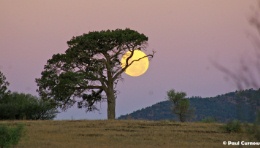09 September 2014
 As the weather starts to warm up, a University of South Australia astronomer says there is no better time to get outside and enjoy the free cinema in the sky.
As the weather starts to warm up, a University of South Australia astronomer says there is no better time to get outside and enjoy the free cinema in the sky.
Tonight will be the last chance to see a supermoon this year, but according to UniSA’s Paul Curnow there will be a number of other astronomical highlights to keep people’s gaze upwards in the coming months.
“We have experienced three supermoons this year, which is unusual as there’s usually only one or two. On September 9, we will witness the final supermoon of the year and this one will be biggest yet,” Curnow says.
“The term supermoon is not actually scientifically correct – the proper name is a moon perigee and it occurs when the moon makes its closest approach to Earth during a full moon or a new moon. The Kaurna people of the Adelaide Plains call the full moon Kakirrramunto.
“Towards the end of the month, it will be the supergiant star Antares who will take centre stage. Antares is the largest star in Scorpius constellation and is approximately 600 times larger than the sun. At the end of September, the planet Mars will be very close to Antares – and given Antares rivals Mars in its fiery red colour, it should make for fantastic viewing.”
Curnow, a lecturer at UniSA’s School of Natural and Built Environments, says Mars is racing across the sky this month, headed for Antares. For Australians, the best time to view the red planet and the red star side by side is September 28.
But according to Curnow, who regularly teaches at The Adelaide Planetarium located at UniSA’s Mawson Lakes campus, it’s a meteor shower set to take place on the November 17-18 that may be the show stopper of the year.
“Astronomers actually don’t get that excited about supermoons. It will be the meteor shower taking place in November that will be a highlight for us,” he says.
“It promises to be a spectacular show of shooting stars but it will be a performance reserved for the night owls as it’s going to happen at about 4am.”
But for those out to enjoy the last supermoon of the year, Curnow offers this advice for capturing the event on camera:
“The best time to photograph today’s supermoon will be before 9:30pm. I recommend getting shots as the sun sets and the moon is just on the rise. Choose an interesting horizon which has objects that put the size of the moon into perspective. Over the city skyline, next to some trees or just above the Adelaide Hills are all interesting options,” he says.
Curnow, and colleagues at The Adelaide Planetarium, will deliver a number of courses open to the public in the coming months including ‘Constellations of the Zodiac’ on September 27 and ‘Astronomy for Kids’ on October 25, and ‘Aboriginal Skies’ and ‘Cosmos of Ancient Egypt’ later in the year. For more information, go to www.unisa.edu.au/planetarium.
Contact for interview
Paul Curnow mobile 0402 079 578 email paul.curnow@unisa.edu.au
Media Contact
Rosanna Galvin office (08) 8302 0578 mobile 0434 603 457 email rosanna.galvin@unisa.edu.au




